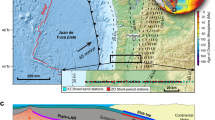Abstract
DEEP sea drilling1 has shown the presence in many parts of the seafloor of a complex sequence of carbonate sediments showing various degrees of dissolution. On the present sea-floor, dissolution of carbonate increases with depth, leading to increasingly poorly preserved carbonate assemblages with increasing depth of deposition, until finally all carbonate is dissolved, leaving a residue of pelagic clay. This relationship between depth and dissolution has been used to interpret the carbonate profiles in drill sites in two contrasting ways. First, assuming that the present distribution of dissolution with depth was constant through time, poorly preserved carbonate skeletons and pelagic clay indicate great depth of deposition, whereas well preserved skeletons and pure chalk indicate a shallow ocean bottom2; second, neglecting tectonic movements, as well as redeposition, the distribution of age versus ocean depth of foraminifera, nannofossils and clay defines the rise and fall of solution levels3,4, such as the calcite compensation depth (CCD) and the (whole test) foraminiferal compensation depth (FCD) somewhat above the CCD.
This is a preview of subscription content, access via your institution
Access options
Subscribe to this journal
Receive 51 print issues and online access
$199.00 per year
only $3.90 per issue
Buy this article
- Purchase on Springer Link
- Instant access to full article PDF
Prices may be subject to local taxes which are calculated during checkout
Similar content being viewed by others
References
JOIDES, Initial Reports of the Deep Sea Drilling Project, 1–7 (US Government Printing Office, Washington DC, 1969–1971).
Hsü, K. J., and Andrews, J. E., in JOIDES, 3 (1970).
Hay, W. W., in JOIDES, 4, 669 (1970).
Hay, W. W., Science, 172, 1197 (1971).
Sverdrup, M. U., Johnson, M. W., and Fleming, R. H., The Oceans, 1004, Fig. 259 (Prentice-Hall, 1942).
Lisitzin, A. P., in The Micropalaeontology of Oceans (edit. by Funnel, B. M., and Riedel, W. R.), 206 (Cambridge University Press, 1971).
Berger, W. H., Deep-Sea Res., 15, 31 (1968).
Berger, W. H., Marine Geol., 8, 111 (1970).
Berger, W. H., Geol. Soc. Amer. Bull., 81, 1385 (1970).
Berger, W. H., Marine Geol., 11, 325 (1971).
Olausson, E., in The Micropalaeontology of Oceans (edit. by Funnell, B. M, and Riedel, W. R.), 375 (Cambridge University Press, 1971).
Sclater, J. G., Anderson, R. N., and Bell, M. L., J. Geophys. Res., 76, 7888 (1971).
Menard, H. W., Earth Planet. Sci. Lett., 6, 275 (1969).
Sclater, J. G., and Francheteau, J., Geophys. J. Roy. Astron. Soc., 20, 509 (1970).
Maxwell, A. E., Von Herzen, R. P., Hsü, K. J., Andrews, J. E., Saito, T., Percival, S. F., Milow, E. D., and Boyce, R. E., Science, 168, 1047 (1970).
Berggren, W. A., J. Foram. Res. (in the press).
Pimm, A. C., in JOIDES, 3, 495 (1970).
Geotimes, 16, (2) 14 (1971).
Geotimes, 15, (10) 12 (1970).
Geotimes, 15, Nos. 2, 4, 7, and 9 (1970).
Geotimes, 16, Nos. 2, 6, and 9 (1971).
Author information
Authors and Affiliations
Rights and permissions
About this article
Cite this article
BERGER, W. Deep Sea Carbonates: Dissolution Facies and Age-Depth Constancy. Nature 236, 392–395 (1972). https://doi.org/10.1038/236392b0
Received:
Revised:
Issue Date:
DOI: https://doi.org/10.1038/236392b0
This article is cited by
-
Dissolution seams: Some observations from the Proterozoic Chanda Limestone, Adilabad, India
Carbonates and Evaporites (1996)
-
Injection events in ocean history
Nature (1978)
-
Deep-sea carbonate and the deglaciation preservation spike in pteropods and foraminifera
Nature (1977)
Comments
By submitting a comment you agree to abide by our Terms and Community Guidelines. If you find something abusive or that does not comply with our terms or guidelines please flag it as inappropriate.



